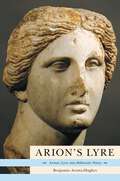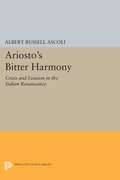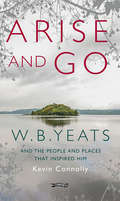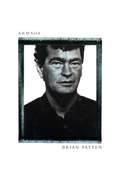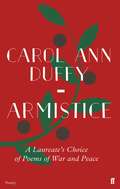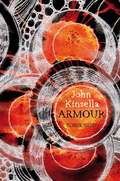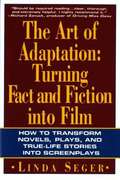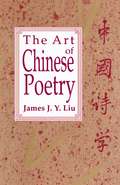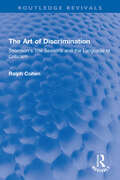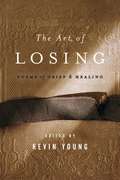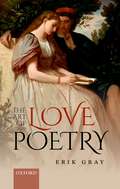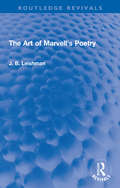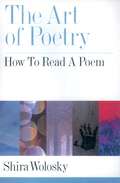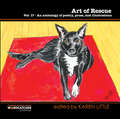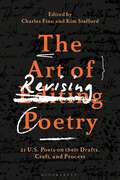- Table View
- List View
Arion's Lyre: Archaic Lyric into Hellenistic Poetry (PDF)
by Benjamin Acosta-HughesArion's Lyre examines how Hellenistic poetic culture adapted, reinterpreted, and transformed Archaic Greek lyric through a complex process of textual, cultural, and creative reception. Looking at the ways in which the poetry of Sappho, Alcaeus, Ibycus, Anacreon, and Simonides was preserved, edited, and read by Hellenistic scholars and poets, the book shows that Archaic poets often look very different in the new social, cultural, and political setting of Hellenistic Alexandria. For example, the Alexandrian Sappho evolves from the singer of Archaic Lesbos but has distinct associations and contexts, from Ptolemaic politics and Macedonian queens to the new phenomenon of the poetry book and an Alexandrian scholarship intent on preservation and codification. A study of Hellenistic poetic culture and an interpretation of some of the Archaic poets it so lovingly preserved, Arion's Lyre is also an examination of how one poetic culture reads another--and how modern readings of ancient poetry are filtered and shaped by earlier readings.
Arion's Lyre: Archaic Lyric into Hellenistic Poetry
by Benjamin Acosta-HughesArion's Lyre examines how Hellenistic poetic culture adapted, reinterpreted, and transformed Archaic Greek lyric through a complex process of textual, cultural, and creative reception. Looking at the ways in which the poetry of Sappho, Alcaeus, Ibycus, Anacreon, and Simonides was preserved, edited, and read by Hellenistic scholars and poets, the book shows that Archaic poets often look very different in the new social, cultural, and political setting of Hellenistic Alexandria. For example, the Alexandrian Sappho evolves from the singer of Archaic Lesbos but has distinct associations and contexts, from Ptolemaic politics and Macedonian queens to the new phenomenon of the poetry book and an Alexandrian scholarship intent on preservation and codification. A study of Hellenistic poetic culture and an interpretation of some of the Archaic poets it so lovingly preserved, Arion's Lyre is also an examination of how one poetic culture reads another--and how modern readings of ancient poetry are filtered and shaped by earlier readings.
Ariosto's Bitter Harmony: Crisis and Evasion in the Italian Renaissance (PDF)
by Albert Russell AscoliFocusing on the fundamental Ariostan pairing of education and madness, with all its implications for poetry, Professor Ascoli generates a global reading of the greatest literary work of the Italian Renaissance.Originally published in 1987.The Princeton Legacy Library uses the latest print-on-demand technology to again make available previously out-of-print books from the distinguished backlist of Princeton University Press. These editions preserve the original texts of these important books while presenting them in durable paperback and hardcover editions. The goal of the Princeton Legacy Library is to vastly increase access to the rich scholarly heritage found in the thousands of books published by Princeton University Press since its founding in 1905.
Arise And Go: W.B. Yeats and the people and places that inspired him
by Kevin ConnollyThe idea of place runs like a river through the life and works of the poet and playwright W.B. Yeats. This book focuses on his time in Dublin, London, Sligo and elsewhere in the west of Ireland, embracing the homes, landscapes and people that impacted his life and stimulated his vast body of work. Meet the poet’s father, the struggling artist John Butler Yeats; his mother Susan, the well-to-do Sligo girl who had no choice but to follow her husband’s path; his five siblings: Lily and Lolly, guiding lights in the Irish Arts and Crafts movement; Jack, the renowned painter; and Bobbie and Jane Grace, who died in infancy. Meet William Morris, John O’Leary, Katharine Tynan, George Moore, Oscar Wilde, Lady Gregory, Douglas Hyde, George Hyde-Lees, and, of course, Maud Gonne, as well as countless others who helped weave the cloth of Yeats’s poetic gift.
Armada
by Brian PattenThrough the fads and fashions of the last thirty years Brian Patten has remained true to his own personal vision of poetry. Whether composing lamentations to the terrible beauty of human love, or writing his outstanding popular verse for children, he has continued to articulate and illuminate the joys and sorrows of the everyday world.
Armistice: A Laureate's Choice of Poems of War and Peace (Faber Poetry Ser.)
by Carol Ann DuffyThe Armistice of 1918 brought ceasefire to the war on the Western Front, but 'the Great War' would not as hoped be 'the war to end all wars'. In this affecting selection, the Poet Laureate, Carol Ann Duffy, guides us deep into the act and root of 'armistice': its stoppage or 'stand' of arms, its search for truce and ceasefire. In 100 poems, our most cherished poets of the Great War speak alongside those from other conflicts and cultures, so that we hear some of the lesser-heard voices of war, including wives, families, those left behind. These poems of war and peace memorialise the horror and the tragedy of conflict. At the same time, in armistice, they become a record of renewal and a testimony to hope.
Armour
by John KinsellaWith Armour, the great Australian poet John Kinsella has written his most spiritual work to date – and his most politically engaged. The world in which these poems unfold is strangely poised between the material and the immaterial, and everything which enters it – kestrel and fox, moth and almond – does so illuminated by its own vivid presence: the impression is less a poet honouring his subjects than uncannily inhabiting them. Elsewhere we find a poetry of lyric protest, as Kinsella scrutinizes the equivocal place of the human within this natural landscape, both as tenant and self-appointed steward. Armour is a beautifully various work, one of sharp ecological and social critique – but also one of meticulous invocation and quiet astonishment, whose atmosphere will haunt the reader long after they close the book. Praise for John Kinsella: ‘Kinsella’s poems are a very rare feat: they are narratives of feeling. Vivid sight – of landscapes, of animals, of human forms in distant light – becomes insight. There is, often, the shock of the new. But somehow awaited, even familiar. Which is the homecoming of a true poet’ George Steiner
The Art and Thought of the "Beowulf" Poet
by Leonard NeidorfIn The Art and Thought of the Beowulf Poet, Leonard Neidorf explores the relationship between Beowulf and the legendary tradition that existed prior to its composition. The Beowulf poet inherited an amoral heroic tradition, which focused principally on heroes compelled by circumstances to commit horrendous deeds: fathers kill sons, brothers kill brothers, and wives kill husbands. Medieval Germanic poets relished the depiction of a hero's unyielding response to a cruel fate, but the Beowulf poet refused to construct an epic around this traditional plot. Focusing instead on a courteous and pious protagonist's fight against monsters, the poet creates a work that is deeply untraditional in both its plot and its values. In Beowulf, the kin-slayers and oath-breakers of antecedent tradition are confined to the background, while the poet fills the foreground with unconventional characters, who abstain from transgression, display courtly etiquette, and express monotheistic convictions. Comparing Beowulf with its medieval German and Scandinavian analogues, The Art and Thought of the Beowulf Poet argues that the poem's uniqueness reflects one poet's coherent plan for the moral renovation of an amoral heroic tradition. In Beowulf, Neidorf discerns the presence of a singular mind at work in the combination and modification of heroic, folkloric, hagiographical, and historical materials. Rather than perceive Beowulf as an impersonally generated object, Neidorf argues that it should be read as the considered result of one poet's ambition to produce a morally edifying, theologically palatable, and historically plausible epic out of material that could not independently constitute such a poem.
The Art of Adaptation: Turning Fact and Fiction into Film (PDF)
by Linda SegerAdaptations have long been a mainstay of Hollywood and the television networks. Indeed, most Academy Award- and Emmy Award-winning films have been adaptations of novels, plays, or true-life stories. Linda Seger, author of two acclaimed books on scriptwriting, now offers a comprehensive handbook for screenwriters, producers, and directors who want to successfully transform fictional or factual material into film. Seger tells how to analyze source material to understand why some of it resists adaptation. She then gives practical methods for translating story, characters, themes, and style into film. A final section details essential information on how to adapt material and how to protect oneself legally
The Art of Chinese Poetry
by James J. LiuThis concise introduction to Chinese poetry serves as a primer for English-speakers eager to expand their understanding and enjoyment of Chinese culture. James J. Y. Liu first examines the Chinese language as a medium of poetic expression and, contrary to the usual focus on the visual qualities of Chinese script, emphasizes the auditory effects of Chinese verse. He provides a succinct survey of Chinese poetry theory and concludes with his own view of poetry, based upon traditional Chinese concepts. "[This] books should be read by all those interested in Chinese poetry."—Achilles Fang, Poetry "[This is] a significant contribution to the understanding and appreciation of Chinese poetry, lucidly presented in a way that will attract a wide audience, and offering an original synthesis of Chinese and Western views that will stimulate and inspire students of poetry everywhere."—Hans H. Frankel, Harvard Journal of Asiatic Studies "This is a book which can be recommended without reservation to anyone who wants to explore the world of Chinese poetry in translation."—James R. Hightower, Journal of Asian Studies
The Art of Discrimination: Thomson's The Seasons and the Language of Criticism (Routledge Revivals)
by Ralph CohenFirst published in 1964, The Art of Discrimination is a study in the relation between critical theory and practice, taking as its test-case James Thomson’s The Seasons, the poem which was, according to Johnson, of "a new kind". Professor Cohen explores the different applications of criticism from 1750 to 1950, analysing specific interpretations of the poem that altered, contradicted or supported poetic theory. In doing so, he introduces new techniques to supplement traditional critical commentary: illustrations are treated as interpretations and critical language is related to non-literary as well as literary information. In treating the history of critical interpretation, the reprinting of editions and past interpretations are considered along with contemporary statements as necessary to define a literary period. The book offers alternatives to theories of organicism and to those of the arbitrariness of literary history by defining the kinds of continuities that exist in criticism. As analysis of criticism, it studies how men think about literature, the extent to which such thinking resists systematization and those elements in it which can be controlled and organized and transmitted. The book will appeal to students of literature and critical theory.
The Art of Discrimination: Thomson's The Seasons and the Language of Criticism (Routledge Revivals)
by Ralph CohenFirst published in 1964, The Art of Discrimination is a study in the relation between critical theory and practice, taking as its test-case James Thomson’s The Seasons, the poem which was, according to Johnson, of "a new kind". Professor Cohen explores the different applications of criticism from 1750 to 1950, analysing specific interpretations of the poem that altered, contradicted or supported poetic theory. In doing so, he introduces new techniques to supplement traditional critical commentary: illustrations are treated as interpretations and critical language is related to non-literary as well as literary information. In treating the history of critical interpretation, the reprinting of editions and past interpretations are considered along with contemporary statements as necessary to define a literary period. The book offers alternatives to theories of organicism and to those of the arbitrariness of literary history by defining the kinds of continuities that exist in criticism. As analysis of criticism, it studies how men think about literature, the extent to which such thinking resists systematization and those elements in it which can be controlled and organized and transmitted. The book will appeal to students of literature and critical theory.
The Art Of Life
by Paul DurcanIn The Art of Life Paul Durcan takes us around County Mayo in his "filthy, two-door, bottle-green Opel Astra", stopping off at Westport and Achill Island, where he declares himself to be "globally sad", but "locally glad". Next he travels east to Dublin to hold in his arms his newborn granddaughter and thence to Tuscany, Poland and Japan. Along the way he reflects upon parental pride, the aches and pains of old age, the trim bottoms of snooker players, the wisdom of ex-wives and dogs on Sandymount Strand, while introducing us to a host of colourful characters, including a bishop, a roofer, a milkman, a priest and an unmarried mother. Is there an art of living or is life a work of art? This magnificent collection - originally published on Paul Durcan's sixtieth birthday - reveals one of Ireland's most successful and popular poets at the height of his powers and continuing to challenge, amuse and delight.
The Art of Losing: Poems of Grief and Healing
by Kevin Young“Kevin Young has thoughtfully gathered many of these sorrowful perambulations and grievous plummets.” -Billy CollinsThe Art of Losing is the first anthology of its kind, delivering poetry with a purpose. Editor Kevin Young has introduced and selected 150 devastatingly beautiful poems that embrace the pain and heartbreak of mourning. Divided into five sections (Reckoning, Remembrance, Rituals, Recovery, and Redemption), with poems by some of our most beloved poets as well as the best of the current generation of poets, The Art of Losing is the ideal gift for a loved one in a time of need and for use by therapists, ministers, rabbis, and palliative care workers who tend to those who are experiencing loss. Among the poets included: Elizabeth Alexander, W. H. Auden, Amy Clampitt, Billy Collins, Emily Dickinson, Louise Gluck, Ted Hughes, Galway Kinnell, Kenneth Koch, Philip Larkin, Li-Young Lee, Philip Levine, Marianne Moore, Sharon Olds, Mary Oliver, Robert Pinsky, Adrienne Rich, Theodore Roethke, Anne Sexton, Wallace Stevens, Dylan Thomas, Derek Walcott, and James Wright.
The Art of Love Poetry
by Erik GrayLove begets poetry; poetry begets love. So thinkers from Plato onwards have claimed; and even today, when poetry has largely disappeared from the mainstream of popular culture, it is still commonly considered the most seductive of all forms of art. But why should this be? What are the connections between poetry and love that lead us to associate them so strongly with one another? In this study Erik Gray draws on a broad range of Western thought and poetry to reveal the qualities and structures that love and poetry share. Above all, he argues, both are founded on paradox. Love is at once necessarily public (because interpersonal) and intensely private; hence love both requires expression and resists it. Likewise the experience of love is simultaneously surprising and familiar, singular and conventional. In poetry, especially lyric poetry - which is similarly both dependent on and resistant to language, both exceptionally regular and exceptionally irregular - love finds a natural outlet. The Art of Love Poetry illuminates many of the recurrent tropes that poets across the centuries have employed to represent and express love, exploring such topics as the poetic kiss, the lyric of conjugal love, and the role of animals in love poetry. In describing the inherent erotics of poetry, it offers new insights not only into the long tradition of love lyric but into the nature of love itself.
The Art of Love Poetry
by Erik GrayLove begets poetry; poetry begets love. So thinkers from Plato onwards have claimed; and even today, when poetry has largely disappeared from the mainstream of popular culture, it is still commonly considered the most seductive of all forms of art. But why should this be? What are the connections between poetry and love that lead us to associate them so strongly with one another? In this study Erik Gray draws on a broad range of Western thought and poetry to reveal the qualities and structures that love and poetry share. Above all, he argues, both are founded on paradox. Love is at once necessarily public (because interpersonal) and intensely private; hence love both requires expression and resists it. Likewise the experience of love is simultaneously surprising and familiar, singular and conventional. In poetry, especially lyric poetry - which is similarly both dependent on and resistant to language, both exceptionally regular and exceptionally irregular - love finds a natural outlet. The Art of Love Poetry illuminates many of the recurrent tropes that poets across the centuries have employed to represent and express love, exploring such topics as the poetic kiss, the lyric of conjugal love, and the role of animals in love poetry. In describing the inherent erotics of poetry, it offers new insights not only into the long tradition of love lyric but into the nature of love itself.
The Art of Marvell's Poetry (Routledge Revivals)
by J. B. LeishmanFirst Published in 1966, The Art of Marvell's Poetry presents J.B. Leishman’s appreciation of Andrew Marvell’s poems by demonstrating a sensitive understanding of attitudes peculiar to the seventeenth century and to Marvell. Leishman calls Marvell an "inveterate imitator and experimenter". His success depended on originality of combination rather than originality of invention. But while such phrases as "Musick, the Mosaique of the Air,’’ "Desarts of vast Eternity,"- and "a green Thought in a green shade" were certainly inspired by others, they are distinctively and unquestionably Marvell’s own. Marvell’s poetry is shown to be the work of a man living at a certain moment in history; it is poetry which could not have been written at any other time, and its affinities to the work of contemporary poets are clearly demonstrated. The Art of Marvell's Poetry is a must read for scholars and researchers of English poetry, English literature, and European literature.
The Art of Marvell's Poetry (Routledge Revivals)
by J. B. LeishmanFirst Published in 1966, The Art of Marvell's Poetry presents J.B. Leishman’s appreciation of Andrew Marvell’s poems by demonstrating a sensitive understanding of attitudes peculiar to the seventeenth century and to Marvell. Leishman calls Marvell an "inveterate imitator and experimenter". His success depended on originality of combination rather than originality of invention. But while such phrases as "Musick, the Mosaique of the Air,’’ "Desarts of vast Eternity,"- and "a green Thought in a green shade" were certainly inspired by others, they are distinctively and unquestionably Marvell’s own. Marvell’s poetry is shown to be the work of a man living at a certain moment in history; it is poetry which could not have been written at any other time, and its affinities to the work of contemporary poets are clearly demonstrated. The Art of Marvell's Poetry is a must read for scholars and researchers of English poetry, English literature, and European literature.
The Art of Poetry
by Paul Valéry Denise FolliotAll of the major meditations on the theory and practice of poetry by one of the greatest poets of our time--and perhaps the one who has most scrupulously analyzed his art--are included in The Art of Poetry.Originally published in 1985.The Princeton Legacy Library uses the latest print-on-demand technology to again make available previously out-of-print books from the distinguished backlist of Princeton University Press. These editions preserve the original texts of these important books while presenting them in durable paperback and hardcover editions. The goal of the Princeton Legacy Library is to vastly increase access to the rich scholarly heritage found in the thousands of books published by Princeton University Press since its founding in 1905.
The Art of Poetry: How to Read a Poem
by Shira WoloskyIn The Art of Poetry, Shira Wolosky provides a dazzling introduction to an art whose emphasis on verbal music, wordplay, and dodging the merely literal makes it at once the most beguiling and most challenging of literary forms. A uniquely comprehensive, step-by-step introduction to poetic form, The Art of Poetry moves progressively from smaller units such as the word, line, and image, to larger features such as verse forms and voice. In fourteen engaging, beautifully written chapters, Wolosky explores in depth how poetry does what it does while offering brilliant readings of some of the finest lyric poetry in the English and American traditions. Both readers new to poetry and poetry veterans will be moved and enlightened as Wolosky interprets work by William Shakespeare, John Donne, William Blake, William Wordsworth, Emily Dickinson, Robert Frost, Sylvia Plath, and others. The book includes a superb two-chapter discussion of the sonnet's form and history, and represents the first poetry guide to introduce gender as a basic element of analysis. In contrast to many existing guides, which focus on selected formal aspects like metrics or present definitions and examples in a handbook format, The Art of Poetry covers the full landscape of poetry's subtle art while showing readers how to comprehend a poetic text in all its dimensions. Other special features include Wolosky's consideration of historical background for the developments she discusses, and the way her book is designed to acquaint or reacquaint readers with the core of the lyric tradition in English. Lively, accessible, and original, The Art of Poetry will be a rich source of inspiration for students, general readers, and those who teach poetry.
The Art of Poetry: How to Read a Poem
by Shira WoloskyIn The Art of Poetry, Shira Wolosky provides a dazzling introduction to an art whose emphasis on verbal music, wordplay, and dodging the merely literal makes it at once the most beguiling and most challenging of literary forms. A uniquely comprehensive, step-by-step introduction to poetic form, The Art of Poetry moves progressively from smaller units such as the word, line, and image, to larger features such as verse forms and voice. In fourteen engaging, beautifully written chapters, Wolosky explores in depth how poetry does what it does while offering brilliant readings of some of the finest lyric poetry in the English and American traditions. Both readers new to poetry and poetry veterans will be moved and enlightened as Wolosky interprets work by William Shakespeare, John Donne, William Blake, William Wordsworth, Emily Dickinson, Robert Frost, Sylvia Plath, and others. The book includes a superb two-chapter discussion of the sonnet's form and history, and represents the first poetry guide to introduce gender as a basic element of analysis. In contrast to many existing guides, which focus on selected formal aspects like metrics or present definitions and examples in a handbook format, The Art of Poetry covers the full landscape of poetry's subtle art while showing readers how to comprehend a poetic text in all its dimensions. Other special features include Wolosky's consideration of historical background for the developments she discusses, and the way her book is designed to acquaint or reacquaint readers with the core of the lyric tradition in English. Lively, accessible, and original, The Art of Poetry will be a rich source of inspiration for students, general readers, and those who teach poetry.
Art of Rescue: An anthology of poetry, prose and illustrations (Creative Portfolio Series #17)
by Various AuthorsEight writers weave words about their rescue pet, in poetry or prose. I hope in bringing together my drawings of adopted pets and their stories, we can demonstrate how wonderful shelter pets are. All author royalties from the sale of this book will be donated to the animal shelter EPAT.
The Art of Revising Poetry: 21 U.S. Poets on their Drafts, Craft, and Process
by Charles Finn and Kim StaffordUsing side-by-side pairings of first drafts and final versions, including full-page reproductions from the poets' personal notebooks, as well as an insightful essay on each poem's journey from start to finish, The Art of Revising Poetry tracks the creative process of twenty-one of the United States' most influential poets as they struggle over a single word, line break, or thought. This behind-the-scenes look into the creative minds of working poets, including African American, Latino, Asian American, and Native poets from across the US, is an essential resource for students practicing poetry, and for instructors looking to enliven the classroom with real world examples. Students learn first-hand from the deft revisions working poets make, while poetry teachers can show in detail how experienced poets self-edit, tinker, cut, rearrange, and craft a poem. The Art of Revising Poetry is a must-have for aspiring poets and poetry teachers at all levels.
The Art of Revising Poetry: 21 U.S. Poets on their Drafts, Craft, and Process
Using side-by-side pairings of first drafts and final versions, including full-page reproductions from the poets' personal notebooks, as well as an insightful essay on each poem's journey from start to finish, The Art of Revising Poetry tracks the creative process of twenty-one of the United States' most influential poets as they struggle over a single word, line break, or thought. This behind-the-scenes look into the creative minds of working poets, including African American, Latino, Asian American, and Native poets from across the US, is an essential resource for students practicing poetry, and for instructors looking to enliven the classroom with real world examples. Students learn first-hand from the deft revisions working poets make, while poetry teachers can show in detail how experienced poets self-edit, tinker, cut, rearrange, and craft a poem. The Art of Revising Poetry is a must-have for aspiring poets and poetry teachers at all levels.
The Art of Shakespeare's Sonnets
by Helen VendlerHelen Vendler, widely regarded as our most accomplished interpreter of poetry, here serves as an incomparable guide to some of the best-loved poems in the English language. In detailed commentaries on Shakespeare's 154 sonnets, Vendler reveals previously unperceived imaginative and stylistic features of the poems, pointing out not only new levels of import in particular lines, but also the ways in which the four parts of each sonnet work together to enact emotion and create dynamic effect.
